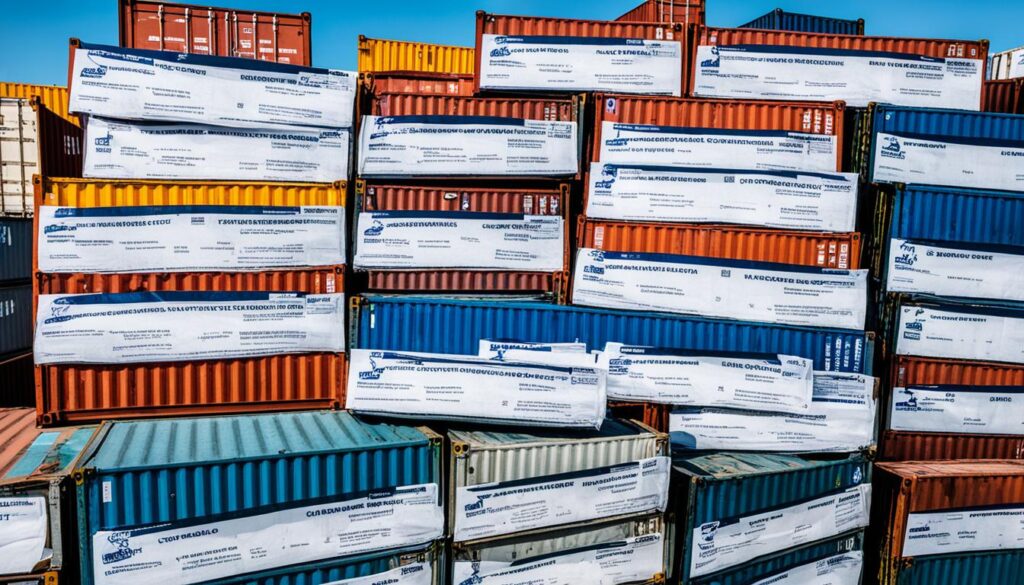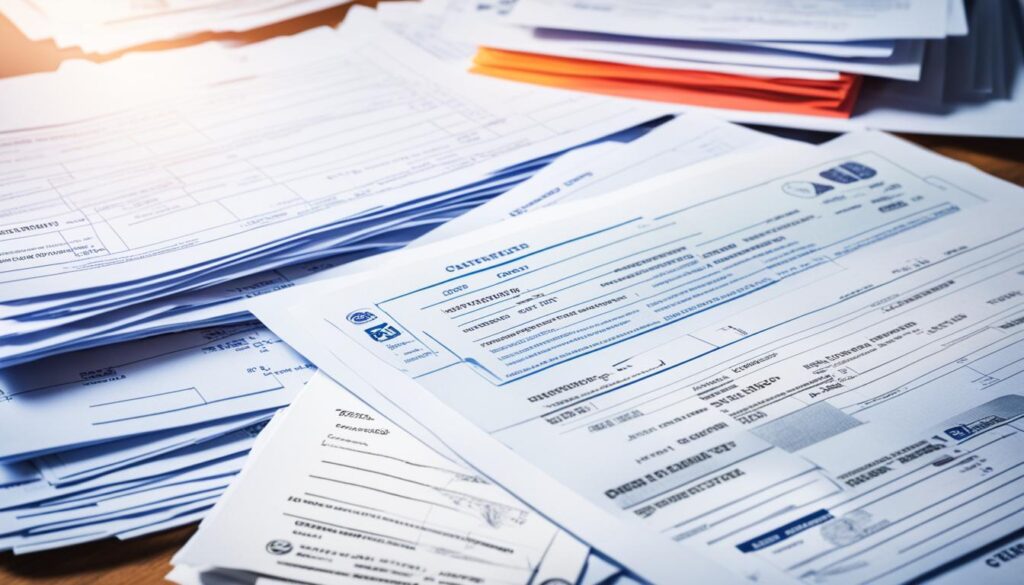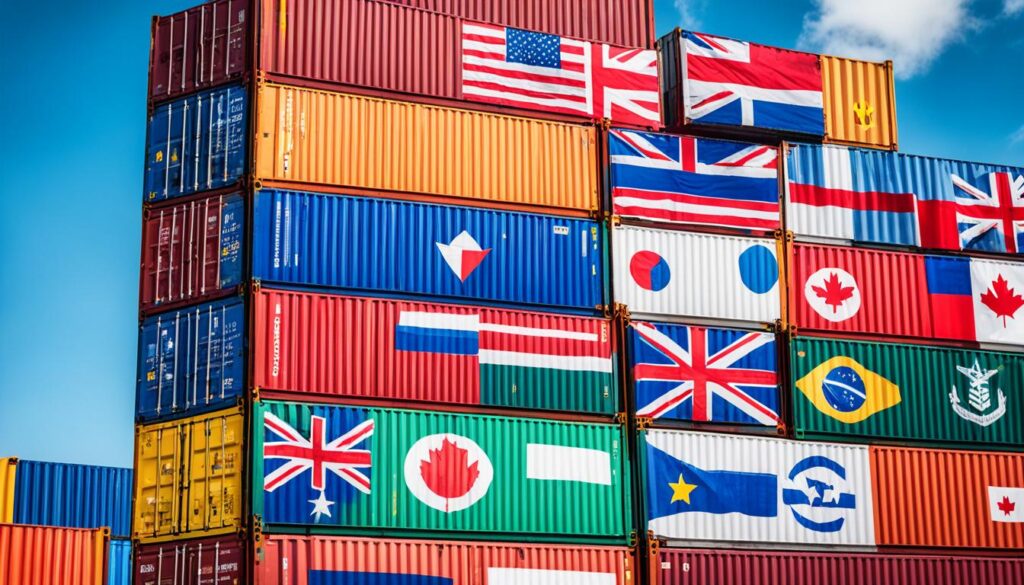Welcome to my comprehensive guide on trade documentation for international trade. Have you ever wondered about the intricate paperwork involved in import-export transactions? How do businesses ensure compliance with customs regulations and payment terms? Join me as I unravel the mysteries of trade documentation and explore its significance in the world of global commerce.
Key Takeaways:
- Trade documentation is crucial for seamless import-export processes in international trade.
- Clear contracts play a vital role in avoiding misunderstandings and disputes.
- Specific documents are required for customs clearance and compliance.
- Transport documentation ensures proper handling and delivery of goods.
- Payment documents guarantee a smooth financial transaction between buyers and sellers.
Importance of Clear Contracts in Trade Documentation
When it comes to trade documentation, clear and detailed contracts play a crucial role in ensuring smooth import-export processes. These contracts serve as a legally binding agreement between the buyer and the seller, providing clarity and defining the responsibilities of each party involved in the transaction.
Clear contracts are essential in mitigating misunderstandings and disputes that may arise during the trade journey. By clearly stating the delivery location, responsibilities at each stage of the journey, and agreed-upon terms, both the buyer and the seller can have a solid understanding of their obligations and expectations.
Contracts also help establish a sense of trust and accountability between the parties. When both sides are aware of their respective responsibilities, it fosters a transparent and cooperative environment for successful trade transactions.
Here is an example of a clear contract for an import-export transaction:
Contract for Import-Export Transaction
Buyer: [Buyer’s Name]
Seller: [Seller’s Name]
Product: [Product Name]
Delivery Location: [Delivery Location]
Responsibilities:
- The seller is responsible for packaging and preparing the goods for shipment.
- The seller is responsible for booking the transportation services and providing the necessary transport documentation.
- The buyer is responsible for paying the agreed-upon price and any applicable taxes or duties upon delivery.
Payment Terms:
- The buyer will make a 30% down payment upon signing the contract, with the remaining amount to be paid upon delivery.
- Payment will be made via bank transfer.
| Delivery Location | Responsibilities |
|---|---|
| [Delivery Location] |
|
| [Delivery Location] |
|
Having clear contracts not only ensures a smooth trade journey but also provides a solid foundation for resolving any potential disputes that may arise. By clearly defining the responsibilities and expectations of each party, trade transactions can be conducted with confidence and peace of mind.

Documents Required for Customs Clearance
When it comes to international trade, customs clearance is a crucial step in ensuring the smooth movement of goods across borders. To successfully navigate this process, it is essential to have the correct trade documentation in place. Proper documentation not only facilitates customs clearance but also helps determine the duty and tax charges applicable to the goods.
Here are some of the key documents that are typically required for customs clearance:
- Commercial Invoices: These documents provide a detailed description of the goods being imported or exported, including their value and quantity. Invoices should be accurate and transparent, clearly outlining the terms of the transaction.
- Packing Lists: Packing lists contain information about how the goods are packed, including the number of packages, their dimensions, and weight. These lists assist customs authorities in assessing the accuracy of the shipment and help ensure that the goods are properly documented.
- Certificates of Origin: Certificates of origin certify the country in which the goods were produced or manufactured. They are crucial in determining the duty rates and trade agreements applicable to the goods.
- Transport Documents: Transport documents, such as bills of lading or airway bills, provide proof of shipment and ownership of the goods. They detail the terms and conditions of transportation, including the carrier, the destination, and the consignee.
By having these essential documents ready for customs clearance, you can expedite the process and minimize the risk of delays or additional charges. Compliance with customs regulations is essential to avoid penalties and ensure a smooth flow of goods.

Importance of Transport Documentation in Trade
Transport documentation plays a vital role in the efficient and secure movement of goods during international trade. It provides crucial instructions to carriers regarding the handling and delivery of the goods, ensuring they reach their destination in a timely and secure manner. In addition, transport documentation helps define the responsibility and ownership of the goods throughout their journey, mitigating any disputes that may arise.
A range of transport documents is used in trade transactions, including:
- Shipping Instructions: These documents outline specific instructions to carriers regarding the shipment, such as pickup and delivery locations, mode of transport, and any special handling requirements.
- Shipping Notes: These notes summarize key details about the shipment, including the contents, packaging, weight, and dimensions.
- Bills of Lading: Bills of lading serve as a contract between the shipper and the carrier, acknowledging receipt of the goods and specifying the terms of the transportation agreement.
- Waybills: Waybills are non-negotiable transport documents that provide information about the goods being shipped and their destination. They serve as proof of contract and receipt for the goods.
Accurate and comprehensive transport documentation is essential for a seamless trade process. It ensures that carriers have the necessary instructions to handle the goods responsibly and deliver them according to the agreed-upon terms. Additionally, transport documentation enables transparency and accountability, protecting the interests of both the buyer and the seller.
When transport documentation is well-prepared and properly executed, it facilitates compliance with trade regulations and minimizes the risk of delays, loss, or damage during transit. Adhering to regulatory requirements and providing carriers with clear and complete transport documentation is crucial for a successful international trade transaction.

Payment Documents in Trade Transactions
In international trade transactions, payment documents play a vital role in ensuring a smooth and secure exchange of goods and funds between buyers and sellers. Different payment methods require specific documents that provide guarantees and instructions for the payment process, reducing risks for both parties involved.
Common payment documents in trade transactions include:
- Bills of Exchange: These are negotiable instruments that serve as written orders from the exporter to the importer, instructing them to make payment at a specific future date or upon presentation of the bill.
- Documentary Collections: This payment method involves the use of trade documents, such as invoices, bills of lading, and transport documents, which are sent through banks. The banks facilitate the collection of payment from the buyer and release the documents to the buyer upon payment.
- Letters of Credit: A letter of credit is a financial instrument issued by a bank on behalf of the buyer, guaranteeing payment to the seller upon the submission of complying documents. It provides security to both parties by ensuring that payment will be made when the terms and conditions are met.
These payment documents not only provide proof of the agreed-upon payment terms but also serve as evidence in case of disputes or non-payment. They protect the interests of both buyers and sellers and contribute to the overall efficiency and transparency of trade transactions.
Here’s an example of how payment documents help facilitate a trade transaction:
Supplier A in Country X agrees to sell a shipment of goods to Buyer B in Country Y. They decide to use a documentary collection as the payment method. Supplier A prepares the necessary trade documents, including a commercial invoice, packing list, and bill of lading. These documents are handed over to their bank, Bank X, which sends them to Buyer B’s bank, Bank Y, along with instructions for payment. Upon receipt of the documents and confirmation of compliance, Bank Y notifies Buyer B to make payment to Bank Y. Once the payment is received, Bank Y releases the trade documents to Buyer B, who can then claim the shipment from the shipping company.
By utilizing payment documents such as bills of exchange, documentary collections, and letters of credit, trade transactions can be carried out smoothly, providing security and assurance to both buyers and sellers.

Special Documentation Requirements for Controlled Goods
When it comes to international trade, certain goods are subject to special requirements and regulations due to their nature or potential risks. These goods are known as controlled goods, and their transportation and exportation require additional documentation to ensure compliance with regulations.
If you are involved in the trade of controlled goods, it is crucial to be aware of the specific documentation requirements to avoid potential issues and legal consequences. Some of the key documents you may need to obtain include export licenses and proof of insurance.
An export license is a legal document issued by the appropriate government authority that grants permission to export controlled goods. This license ensures that the goods are being exported in accordance with the laws and regulations of both the exporting and importing countries.
In addition to an export license, proof of insurance may also be required for the transportation of controlled goods. This documentation provides evidence that the goods are adequately insured against potential risks during transit. It is important to work with a reputable insurance provider to ensure that you have the appropriate coverage for your controlled goods.
By obtaining the necessary documentation for controlled goods, you demonstrate your commitment to compliance and responsible trade practices. Adhering to these requirements not only helps avoid legal repercussions but also ensures the safe and secure transportation of controlled goods.
Key Points:
- Controlled goods are subject to special requirements and regulations due to their nature or potential risks.
- Export licenses are essential for the legal exportation of controlled goods.
- Proof of insurance provides coverage for potential risks during the transportation of controlled goods.
- Compliance with documentation requirements is vital for responsible trade practices and the safe transportation of controlled goods.
Expert Tip:
Consult with trade compliance experts or international trade lawyers to ensure that you have a thorough understanding of the documentation requirements for controlled goods. They can provide guidance and assist you in navigating the complexities of trade regulations for controlled goods.
Documentation for Compliance with Local Product Standards
When exporting goods, ensuring compliance with the local product standards of the destination market is paramount. Many countries have specific regulations and requirements regarding product quality, safety, and labeling. To meet these standards, it is crucial to research and understand the local requirements and obtain the necessary documentation as proof of compliance.
Local product standards can vary significantly from one country to another. They may include specifications related to product composition, labeling requirements, safety certifications, and environmental considerations. Meeting these standards is essential for gaining market access and ensuring customer satisfaction.
To comply with local product standards, exporters need to provide documentary proof that their goods meet the requirements. This may involve obtaining certification documents, test reports, or conformity assessment documents from recognized third-party laboratories or certification bodies.
Having the proper documentation for compliance with local product standards demonstrates a commitment to quality and regulatory compliance. It also helps build trust with customers and reduces the risk of non-compliance issues, which can result in market rejection, penalties, or legal consequences.
Obtaining and maintaining the necessary documentation for compliance with local product standards should be an integral part of every exporter’s trade documentation process. It not only facilitates market entry but also ensures that products meet the expectations and requirements of customers in the destination market.

Documentation for Dangerous Goods Shipment
When it comes to shipping dangerous goods, proper documentation is of utmost importance to ensure the safety of all parties involved in the transportation process. In addition to the standard trade documentation, there are additional requirements and special paperwork that must be completed.
One of the key documents for shipping dangerous goods is the dangerous goods declaration. This document provides vital information about the nature of the goods, their classification, and any potential hazards associated with them. It helps carriers, handlers, and authorities to take the necessary precautions to ensure the safe handling and transport of these goods.
Another crucial aspect of proper documentation for dangerous goods shipment is the provision of appropriate transport documentation. This includes classifying the goods correctly, labeling the packages appropriately, and providing the necessary safety instructions. Failure to comply with these requirements can lead to significant delays, fines, and even legal consequences.
Transport Document Completion and Compliance
Transport document completion for dangerous goods involves accurately recording all relevant information regarding the shipment. This includes details such as the nature of the goods, their quantity, packaging, and any necessary safety measures. It is essential to ensure the transport document is completed in accordance with the applicable regulations and guidelines.
“Properly completing transport documentation for dangerous goods helps prevent accidents and promotes the safe transport of these potentially hazardous materials.” – [Name of Expert]
The specific requirements for transport document completion may vary depending on the mode of transportation and the regulations of the country of origin and destination. It is vital to stay informed about the latest regulations and seek expert advice when necessary.
Special Paperwork for Dangerous Goods Shipment
In addition to the dangerous goods declaration and transport documentation, there may be additional special paperwork required for shipping hazardous materials. These documents may include:
- Permits and licenses: Some dangerous goods may require specific permits or licenses to ensure compliance with regulatory requirements.
- Certificates of compliance: Certain hazardous materials may require certification to demonstrate compliance with specific standards or regulations.
- Emergency response plans: For high-risk goods, an emergency response plan outlining the necessary actions in case of an incident or accident may be required.
These additional documents help ensure that the proper precautions and safety measures are in place to protect both the people involved in handling the goods and the environment.
| Document | Purpose |
|---|---|
| Dangerous Goods Declaration | To provide essential information about the nature and hazards of the goods being shipped. |
| Transport Documentation | To ensure the accurate recording and communication of important details related to the shipment of dangerous goods. |
| Permits and Licenses | To demonstrate compliance with regulatory requirements and obtain necessary authorization for shipping hazardous materials. |
| Certificates of Compliance | To certify that the dangerous goods meet specific standards or regulations. |
| Emergency Response Plans | To outline the appropriate actions to be taken in the event of an incident or accident involving hazardous materials. |
By fulfilling the requirements for trade documentation and completing the necessary special paperwork, businesses can ensure the safe and compliant shipment of dangerous goods, protecting everyone involved in the transportation process.
Importance of Documentation for Trade Finance
Documentation plays a vital role in trade finance, serving as the foundation for payment and providing evidence of the transaction. It ensures that the parties involved have a clear understanding of their roles, responsibilities, and payment terms. To secure trade finance facilities from banks, it is crucial to have proper trade documentation, including clear contracts, payment documents, and compliance with international trade regulations.
Clear Contracts for Smooth Transactions
Clear contracts are a fundamental component of trade documentation in trade finance. These contracts outline the terms and conditions agreed upon by the parties involved, including payment terms, delivery obligations, and dispute resolution mechanisms. By having a clear contract, both the buyer and the seller can proceed with confidence, knowing their rights and obligations are protected. This minimizes the risk of misunderstandings and disputes during the transaction.
Payment Documents for Financial Security
Payment documents are crucial in trade finance to ensure a smooth financial transaction. These documents provide assurance to banks and other financial institutions that payment obligations will be met. Common payment documents include invoices, bills of exchange, and other proof of payment. By providing comprehensive payment documentation, the parties involved can establish financial security and facilitate the release of funds.
Compliance with International Trade Regulations
Compliance with international trade regulations is paramount in trade finance. Banks require documentation that demonstrates adherence to import-export laws, trade restrictions, and financial regulations. These documents can include import licenses, export permits, certificates of origin, and customs declarations. By meeting these requirements, the risk associated with trade finance transactions is significantly reduced.
Trade Financing Options: Letters of Credit and Bank Guarantees
Trade financing options, such as letters of credit and bank guarantees, also require specific documentation. A letter of credit is a financial instrument issued by a bank that guarantees payment to the seller upon the fulfillment of specified conditions. Bank guarantees, on the other hand, provide assurance to the buyer that the seller will fulfill their contractual obligations. To secure these financing options, precise documentation outlining the terms, conditions, and risks is essential.
Overall, comprehensive trade documentation is vital for trade finance. It provides the necessary evidence, security, and compliance required by banks and financial institutions to facilitate the financing of international trade transactions. By ensuring the accuracy and completeness of trade documentation, businesses can access the financial support they need to grow and expand their global trade ventures.
Importance of Proper Documentation for Customs Compliance
Proper documentation is of utmost importance when it comes to ensuring customs compliance in international trade. Accuracy and completeness in documentation play a significant role in avoiding delays, fines, and penalties. By providing comprehensive import-export documentation, such as commercial invoices, packing lists, and certificates, businesses enable customs authorities to verify the accuracy of the goods being imported or exported. Additionally, these essential documents assist customs authorities in assessing any applicable duties and taxes.
Without proper documentation, the smooth flow of trade transactions can be seriously hindered. Incorrect or incomplete paperwork can result in customs officials holding shipments, causing delays and disruptions to supply chains. Moreover, non-compliance with customs regulations can lead to significant financial implications, including penalties and fines, adversely impacting a company’s bottom line.
“Accurate and complete documentation is the backbone of customs compliance, providing transparency, improving efficiency, and enhancing the trust between importers, exporters, and customs authorities.”
By meticulously preparing import-export documentation, businesses demonstrate their commitment to compliance and transparency. Through detailed documentation, authorities can easily verify the origin, nature, and value of the goods being transported, ensuring adherence to import restrictions, export controls, and other customs regulations.
Moreover, detailed import-export documentation enables customs authorities to collect accurate statistical data, which is crucial for economic analysis and decision-making. This data helps governments assess the impact of international trade on local industries, formulate trade policies, and negotiate trade agreements.
To highlight the importance of proper documentation for customs compliance, consider the following example of a table showcasing the key documents required for import and export processes:
| Import Documents | Export Documents |
|---|---|
| Commercial invoice | Commercial invoice |
| Packing list | Packing list |
| Bill of lading or airway bill | Bill of lading or airway bill |
| Importer Security Filing (ISF) | Shipper’s Letter of Instruction (SLI) |
| Customs entry forms | Customs clearance forms |
| Certificates of origin (if applicable) | Certificates of origin (if applicable) |
| Tariff classification documents | Tariff classification documents |
As shown in the table, both import and export processes require specific documentation to comply with customs regulations. These documents provide vital information to customs authorities, allowing them to verify the accuracy of the transaction, assess duties and taxes, and ensure compliance with trade agreements and restrictions. Neglecting to provide the necessary import-export documentation can result in severe consequences for businesses engaging in international trade.
Obtaining Expert Assistance with Trade Documentation
Handling trade documentation can be complex and time-consuming. As businesses engage in international trade, they often encounter the need for expert assistance to navigate the intricacies of trade documentation and ensure compliance with regulations. Two valuable resources for obtaining such assistance are freight forwarders and local Chambers of Commerce.
Freight forwarders are industry professionals with extensive knowledge and experience in managing trade documentation. They possess a deep understanding of the logistics involved in importing and exporting goods, including the necessary paperwork. Freight forwarders can provide valuable guidance on document requirements, assist in completing forms accurately, and ensure compliance with relevant regulations.
In addition to freight forwarders, businesses can seek assistance from their local Chamber of Commerce. Chambers of Commerce are organizations that support businesses within a specific region. They often offer trade-related services and resources, including expert advice on trade documentation. The Chamber of Commerce serves as a valuable hub of information, connecting businesses with experts who can provide guidance and assistance in navigating the complexities of international trade paperwork.
By leveraging the expertise of freight forwarders and local Chambers of Commerce, businesses can streamline their trade documentation processes and ensure compliance with regulations. These expert resources can save businesses valuable time and effort, allowing them to focus on their core operations and maximizing the efficiency of their international trade endeavors.
Benefits of Obtaining Expert Assistance with Trade Documentation
There are several key benefits to seeking expert assistance with trade documentation:
- Efficiency: Trade documentation professionals can efficiently handle complex paperwork, ensuring accuracy and compliance.
- Expertise: These professionals have in-depth knowledge of international trade regulations and can provide guidance tailored to specific industries and markets.
- Reduced Risks: By relying on experts, businesses can mitigate the risks of errors or non-compliance in their trade documentation processes.
- Time Savings: Delegate the time-consuming task of trade documentation to experts, allowing businesses to focus on core operations.
- Confidence: Expert assistance instills confidence in trade transactions, knowing that the documentation is accurate and compliant.
Importance of Proper Documentation in International Trade
Proper documentation plays a vital role in ensuring the seamless operation of international trade. Without accurate and comprehensive trade documentation, businesses may face significant challenges in navigating the complexities of customs regulations, payment processes, and compliance requirements.
Compliance with customs regulations is a fundamental aspect of international trade. Trade documentation serves as evidence of the legality and legitimacy of the goods being imported or exported. By providing the necessary customs forms, certificates, and invoices, businesses can demonstrate their commitment to transparency and compliance, minimizing the risk of delays, fines, and other penalties.
In addition to customs compliance, proper documentation also facilitates the payment processes involved in international trade. Payment documents, such as bills of exchange, documentary collections, and letters of credit, provide a secure framework for financial transactions between buyers and sellers. By adhering to the specified payment terms and providing the required documentation, businesses can mitigate payment risks and ensure timely and accurate remittance.
Furthermore, accurate and complete trade documentation enhances the overall efficiency of international trade processes. It enables seamless information flow between all parties involved, including suppliers, logistics providers, customs authorities, and financial institutions. By ensuring the consistent availability of trade documentation, businesses can streamline their operations, reduce administrative burdens, and enhance supply chain visibility and traceability.
FAQ
What is trade documentation?
Why are clear contracts important in trade documentation?
What documents are required for customs clearance?
What is the importance of transport documentation in trade?
What are payment documents in trade transactions?
Are there special documentation requirements for controlled goods?
What documentation is required for compliance with local product standards?
What documentation is needed for shipping dangerous goods?
Why is documentation important for trade finance?
How does proper documentation contribute to customs compliance?
Where can I get expert assistance with trade documentation?
Why is proper documentation important in international trade?
Source Links
- https://www.trade.gov/common-export-documents
- https://usacustomsclearance.com/process/documents-needed-for-export-and-import/
- https://www.great.gov.uk/learn/categories/selling-across-borders-product-and-services-regulations-licensing-and-logistics/get-your-goods-into-the-destination-country/understand-documentation-for-international-trade/






